Highly anticipated: 3rd-gen Threadripper is now official starting with a 24-core, 48-thread part that will set you back a handsome $1,400 and only goes up from there, for what is likely going to be insane core heavy performance. We also have news of a new $50 Athlon CPU. Finally, the 16-core Ryzen 9 3950X arrives on November 25, which means a lot for those on the AM4 platform today and a few years down the road, too.
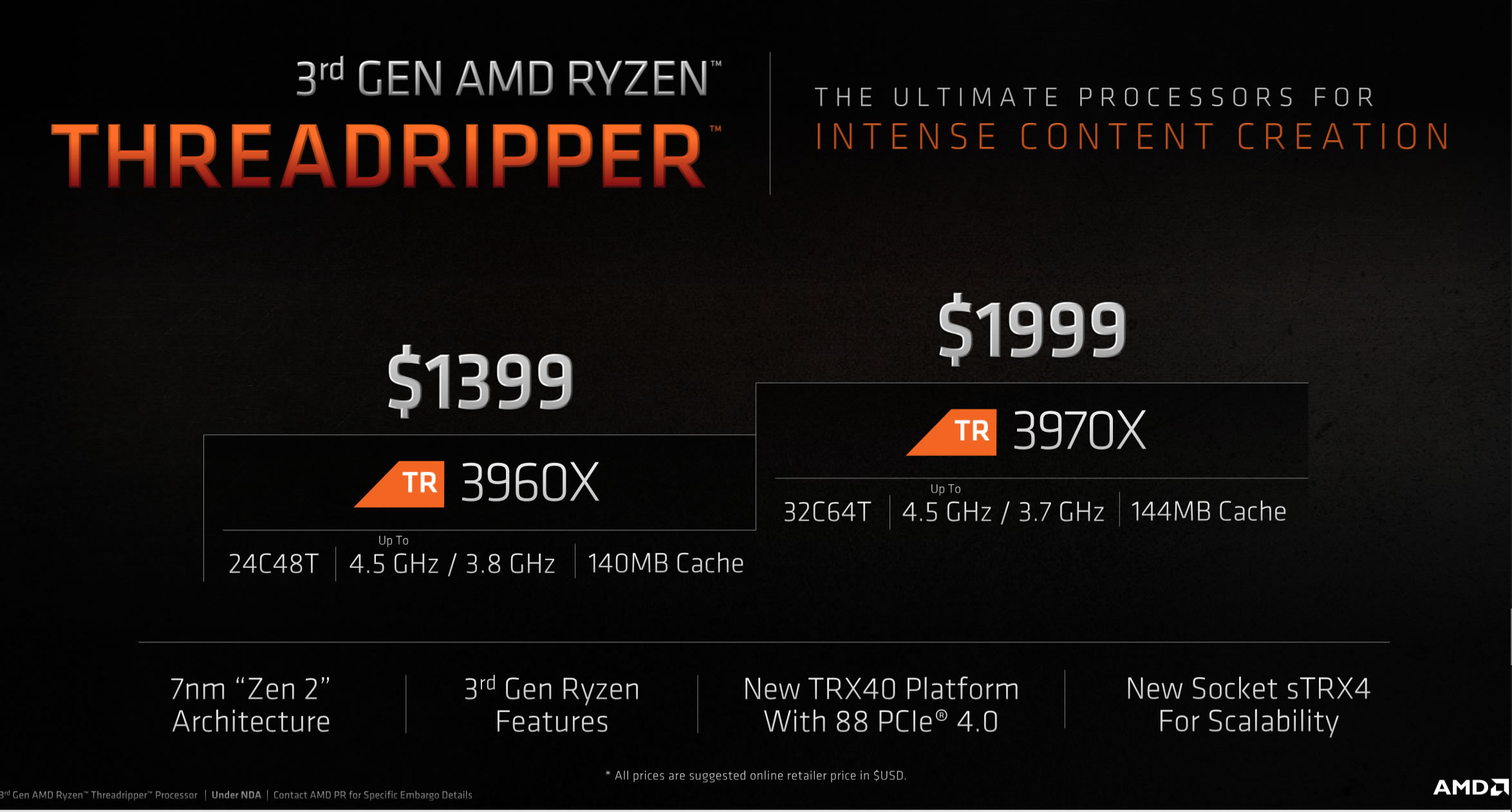
Starting at the top of the food chain is 3rd-gen Threadripper. We knew 24 and 32 core models were nearly guaranteed, but that’s about all we knew prior to this announcement. Of course, the rumor mill has been working overtime on this one, last month we heard that the 64-core flagship 3990X wouldn’t arrive until next year and given the info we have today, that’s entirely possible.
What we can tell you beyond a shadow of a doubt is that the Threadripper 3960X is a 24-core/48-thread part that clocks between 3.8 and 4.5 GHz depending on the workload, and it has a mammoth 140 MB cache. That all sounds amazing and it’s almost certainly going to be, but this entry-level 3rd-gen Threadripper part will set you back an eye watering $1,400. That might sound a bit shocking given the current 24-core 2970WX can be bought for $915, but remember the MSRP on that part was actually $1,300 at launch, so the 3rd-gen version costs $100 more.
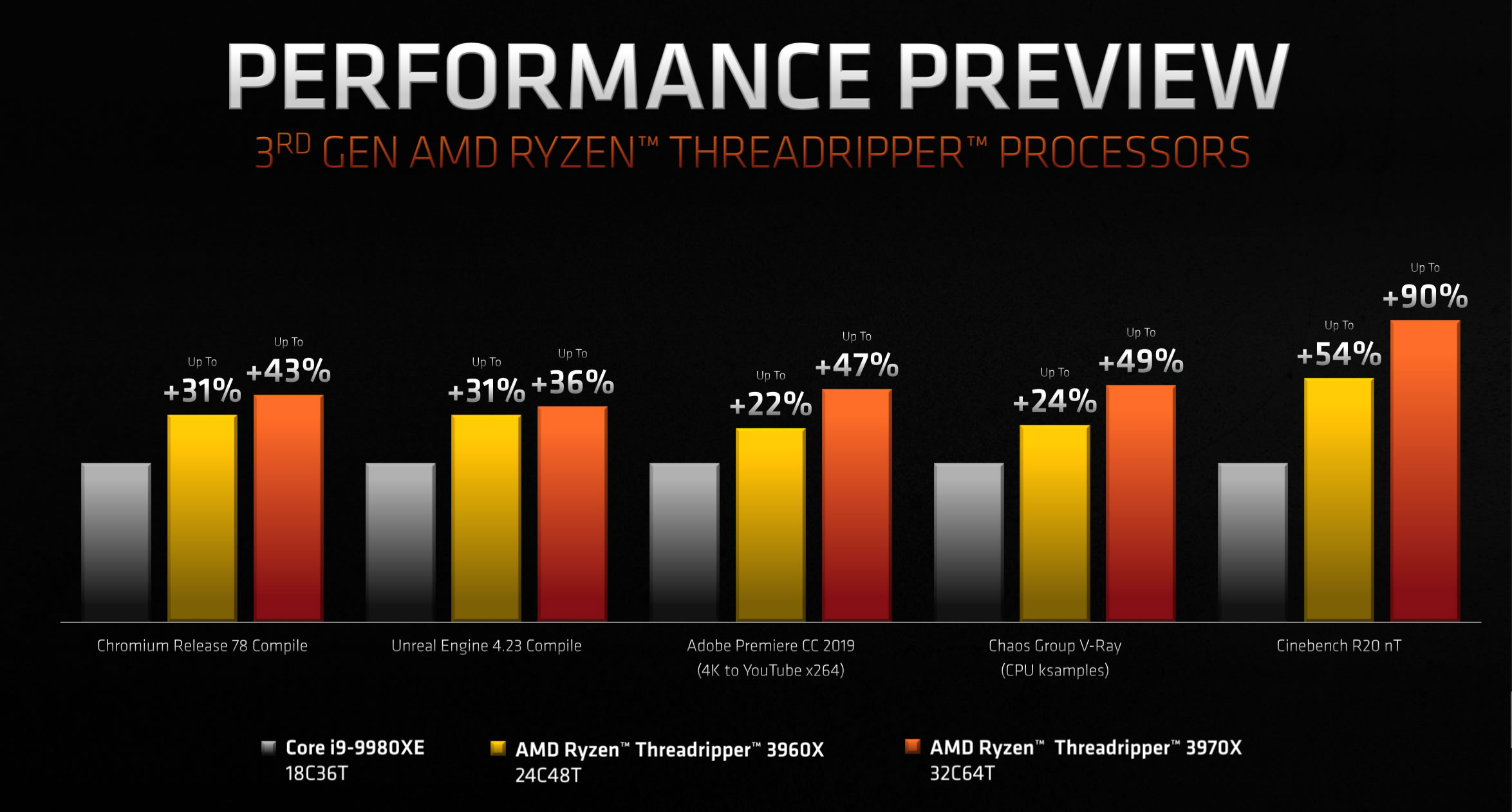
In contrast, Intel's upcoming Core i9-10980XE will cost $1,000, but will be limited to 18 cores. While we don’t know yet how those parts will stack up, AMD's TR 3960X is coming out on top in core heavy workloads for sure. In fact, AMD is showing off their own benchmark that has the 3960X taking on the 9980XE, and in terms of performance we’re expecting Skylake-X and Cascade Lake-X to be the same given it’s just a refresh with a massive price correction. So the 9980XE should be representative of what we see with the 10980XE.
According to AMD, that means Threadripper will be up to 31% faster for compiler work, 22% faster in Adobe Premiere Pro CC, 24% faster for rendering with V-Ray and a massive 54% faster in Cinebench R20. That's for a 40% price premium which may or may not be worth it, hard to say for certain right now.
Speaking of price premiums, you might want to sit down for this one... the Threadripper 3970X is going to be 32-core, 64-thread CPU setting you back a cool $2,000. No doubt this has some bite to it, priced $200 above the 2990WX, it’s going to be the most expensive high-end desktop CPU on the market.
The 3970X clocks between 3.7 and 4.5 GHz and features a whopping 144 MB cache. AMD claims it’s up to 90% faster than the 9980XE in Cinebench R20, 49% faster in V-Ray, 47% in Premiere Pro and then 36 - 43% faster for compilers.
A new TRX platform
AMD has also detailed the new TRX40 platform featuring a mindblowing 72 available PCI 4.0 lanes. There are 88 PCIe lanes in total but 16 of them will be required to use the system as a graphics card is necessary. From the CPU there are 48 PCIe 4.0 lanes which AMD marks as general purpose, as they can be used for anything and will typically be accessible via PCIe expansion slots.
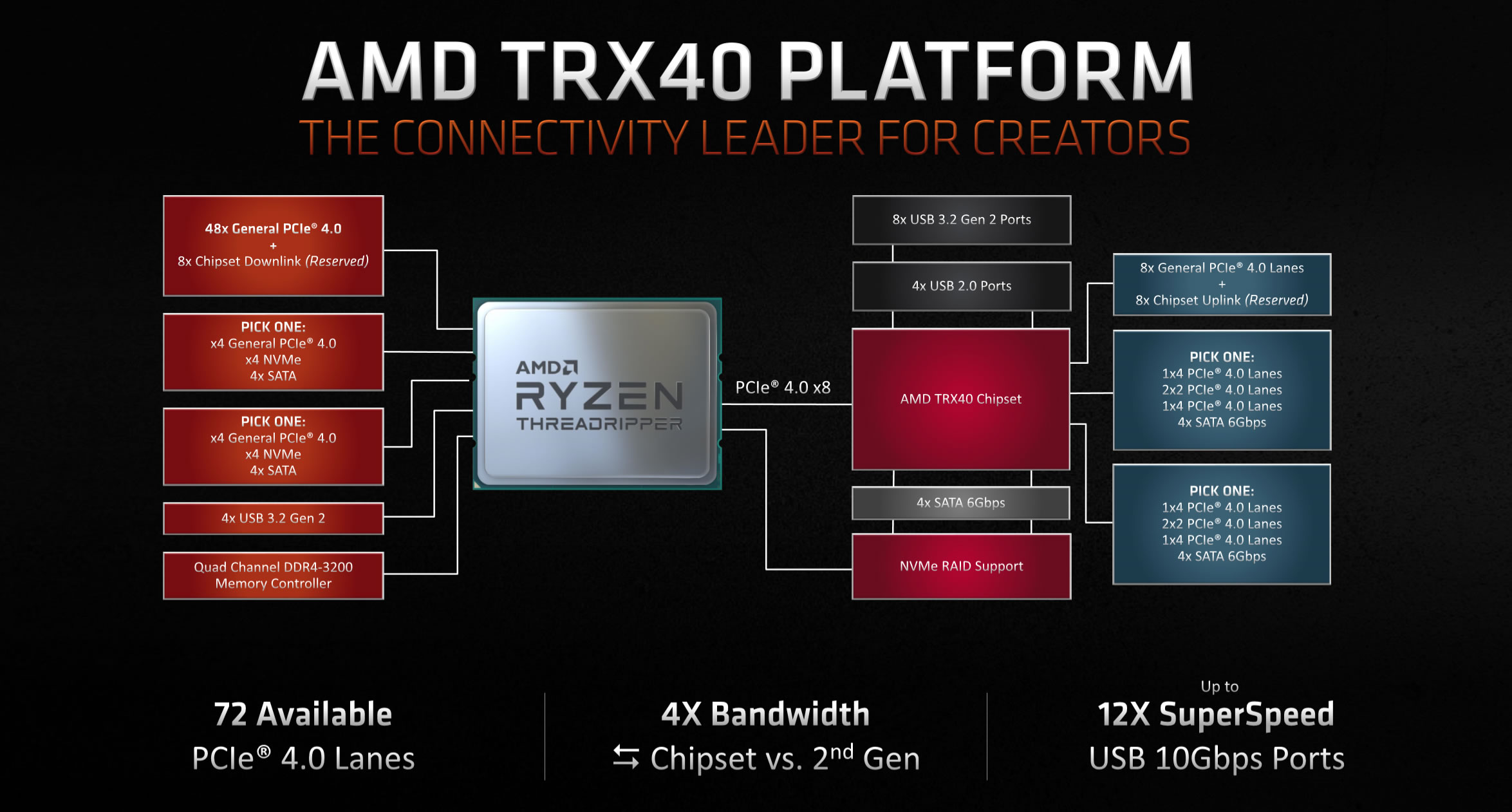
There’s an additional 8 lanes which are split into two 4 lane groups, each can be used to offer either a x4 expansion slot, a x4 NVMe slot or 4 SATA ports. The CPU also supports four USB 3.2 gen 2 ports and a quad channel DDR4-3200 memory controller.
A further 8 PCIe 4.0 lanes connect to the TRX40 chipset, providing four times more CPU-to-chipset bandwidth when compared to 2nd-gen Threadripper. The chipset supports a further 8 USB 3.2 gen 2 ports, four legacy USB 2.0 ports, four SATA 6 Gbps ports and a further 8 PCIe 4.0 general purpose lanes. On top of that there’s another 8 PCIe 4.0 lanes which are reserved and slip into two 4 lane groups. They can each be configured as a single x4 slot, two x2 slots or four x1 slots, or they can also be used to support 4 SATA 6 Gbps ports. The sheer number of expansion possibilities is mind boggling. No doubt we'll see some truly insane TRX40 motherboards.
The only downside here is that TRX40 and TR4 motherboards are not compatible. You won’t be able to use a 3rd-gen Threadripper CPU on an existing X399 board and upcoming TRX40 boards won’t support 1st and 2nd-gen parts.
AMD didn’t make any compatibility promises for Threadripper like they did with AM4. As much as we don’t like this, we also understand it. Cross-compatibility with TR4 would have meant board makers would face all the same issues they’ve run into getting older boards to work, and that still seems to be an ongoing process for 300 and 400-series AM4 motherboards.
Older boards can’t fully take advantage of all the PCIe lanes supported by 3rd-gen Threadripper CPUs, and the X399 chipset lacks PCI 4.0 support. It makes sense that those spending over $1,000 on a CPU, would want a motherboard that can take full advantage of their hardware.
A new $50 CPU
Shifting gears from $2,000 processors to a $50 processor, it’s not often you find an Athlon CPU in the same press deck as flagship Threadripper parts, but that’s exactly what we found. Announced for the first time is the Athlon 3000G, a fully unlocked $50 AM4 dual-core processor with SMT for 4 threads.
Now you might be thinking, we’ve already got that, it’s called the 200GE. However the 200GE is technically a locked part while the 3000G will be unlocked on all AM4 boards that support overclocking, B350 or better.
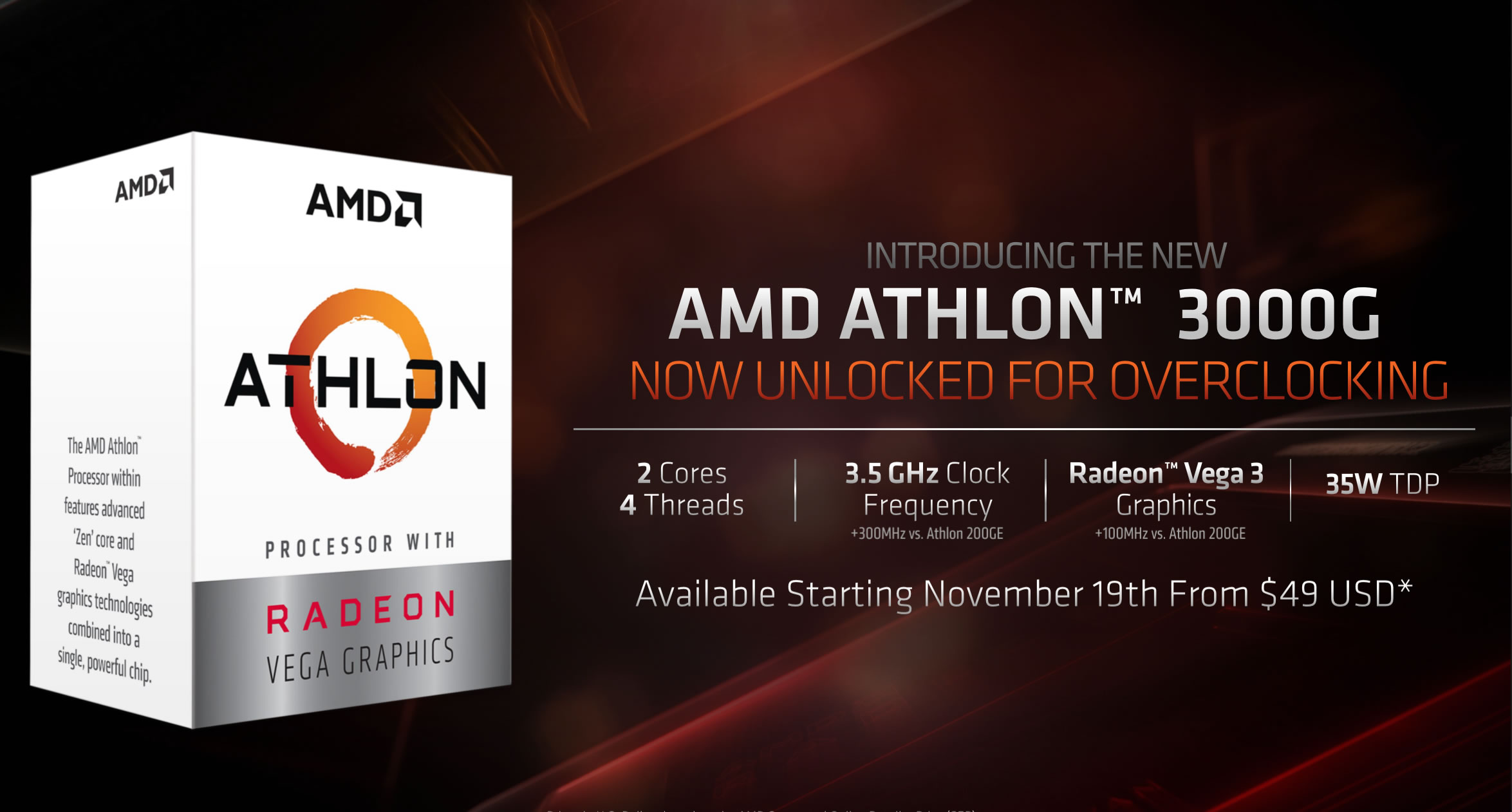
Out of the box it matches the 3.5 GHz clock speed of the 240GE which costs $75, the Vega 3 graphics engine remains the same but it is overclocked by 100 MHz, for a minor performance bump. It’s not the most exciting CPU ever as it’s not Zen 2-based and doesn’t pack a Navi GPU, but it offers a little extra value for just $50. This part will drop on November 19th and we plan to have a full review for prospective budget builders.
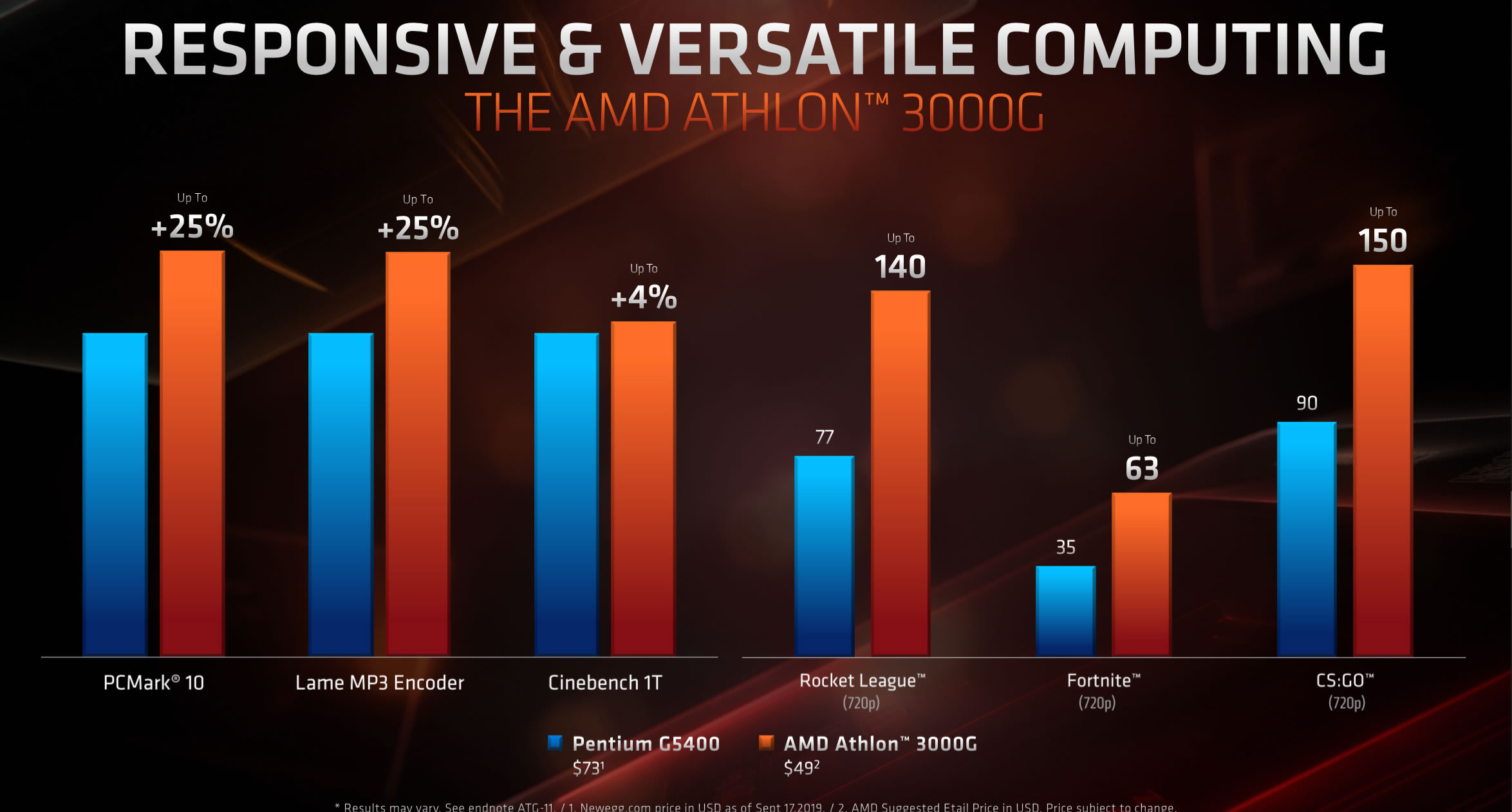
AMD is expecting to slay the Pentium G5400 with the 3000G, offering massive performance gains when comparing iGPU performance and anywhere from 4 to 25% more CPU performance. They also showed overclock gains at 3.9 GHz, so this appears to be a clock speed they believe most parts will achieve.
Ryzen 9 3950X arrives this month
Moving on, we finally have the Ryzen 9 3950X and the main takeaway here is the release date, slated for November 25, hopefully with no further delays. For those of you who aren’t yet up to speed, the 3950X supports the mainstream AM4 socket, it offers 16 cores, 32 threads, clocks between 3.5 and 4.7 GHz and packs a 72 MB cache. For what it’s worth, AMD rates it at 105 W for the TDP, the very same TDP they awarded the 12-core 3900X, though that part does have a higher base clock.
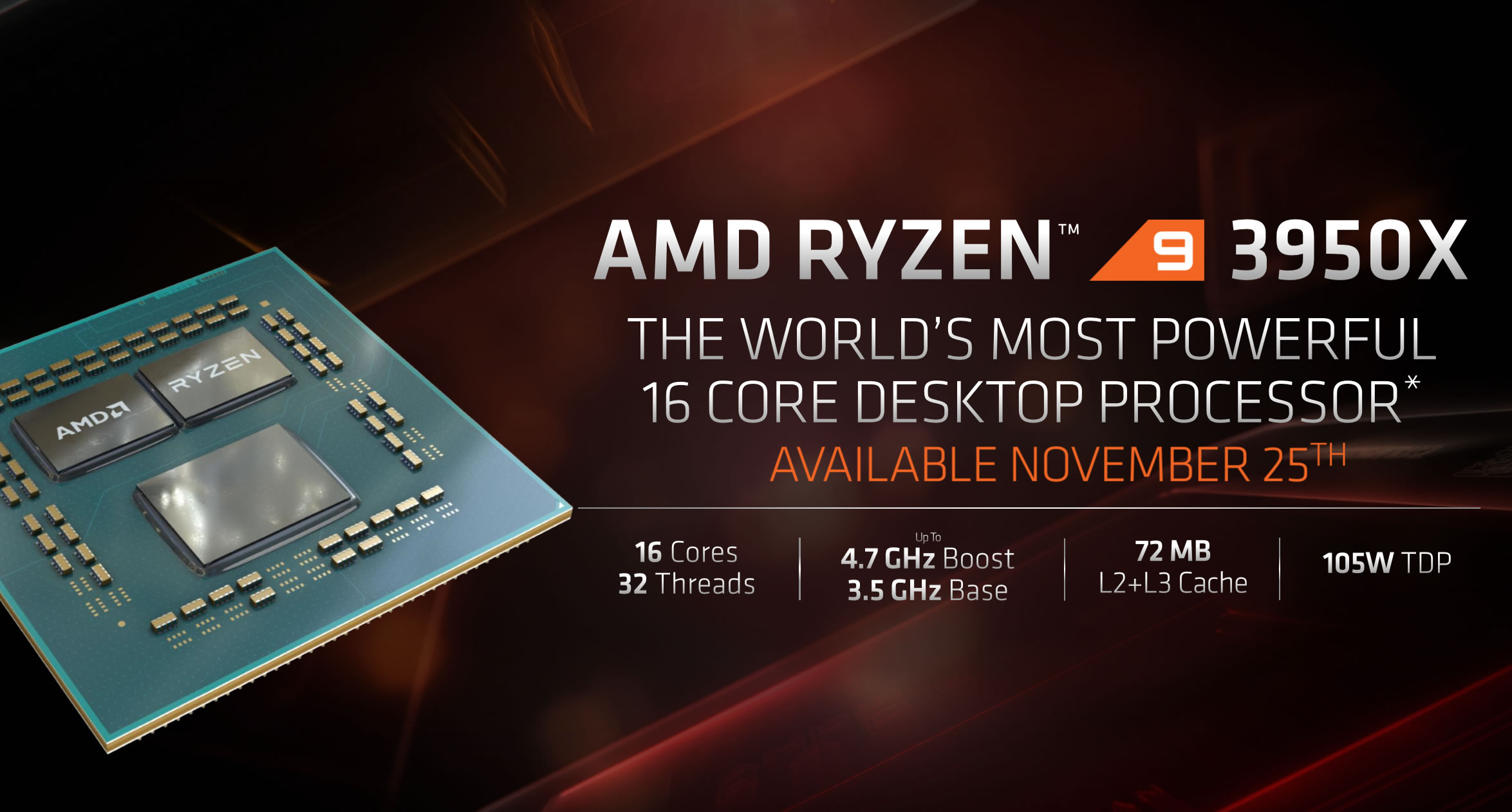
Pricing has been set at $750, or about $47 per core whereas the 3900X and 3700X both cost ~$41 per core. The pointless 3800X is more expensive per core at $50, but as we found a few months ago, you’re best off avoiding that part. You'll be paying a premium for those 16 cores, but that’s to be expected when buying the best quality silicon on the AM4 platform.
AMD says the 3950X will come up against Intel's high-end desktop platform Core i9-9920X which was their 12-core $1,200 part. But in reality, it'll be doing battle with the $700 Core i9-10920X, the refreshed 12-core Cascade Lake-X version that is much easier on the wallet. That will be a very interesting battle indeed. AMD's slides paint the 3950X in a good light as you would expect. Generally AMD's performance estimates are accurate but they can be selective on the numbers they show.
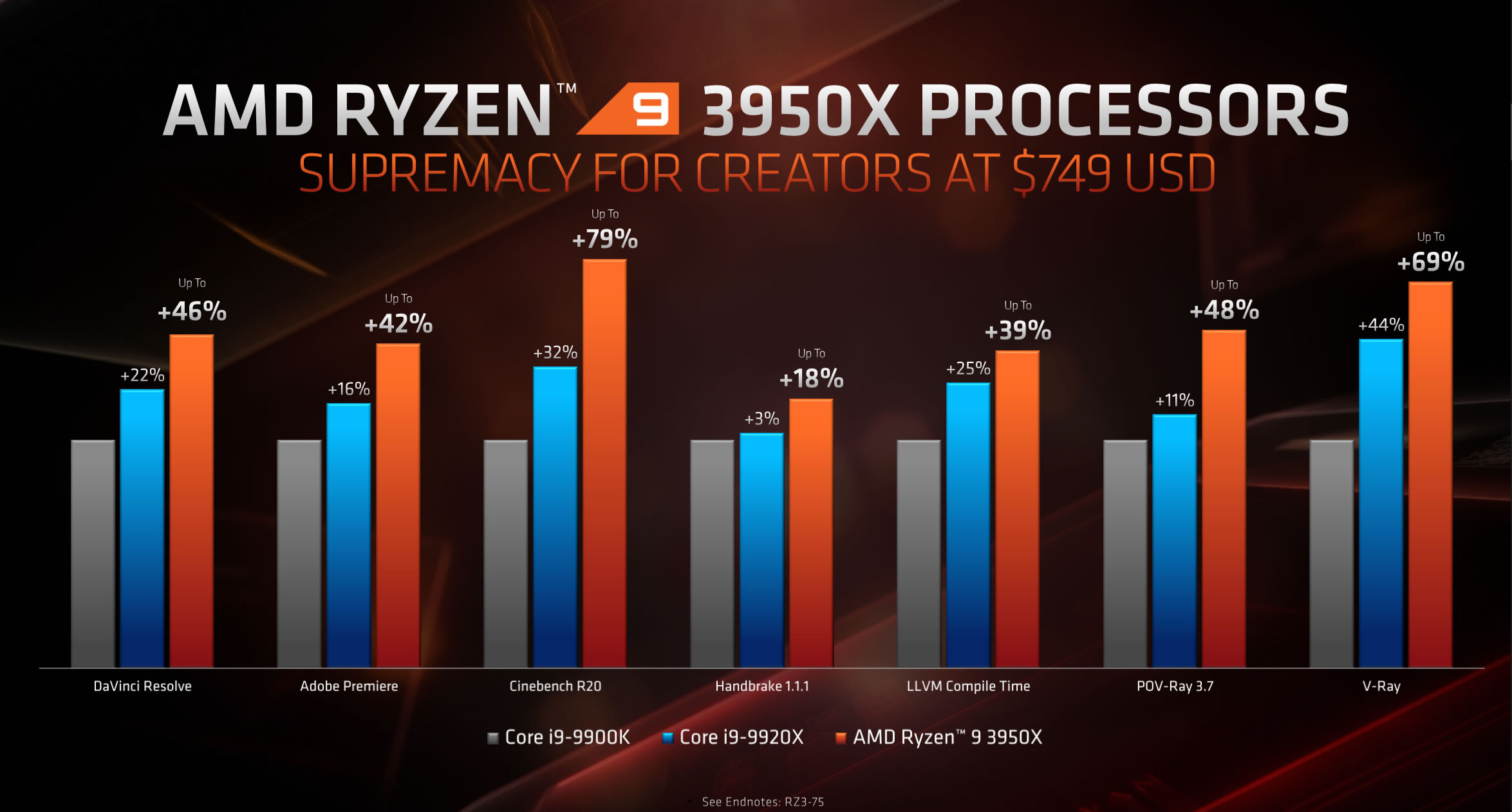
When it comes to gaming performance the 3950X has the 9920X beat, while it’s vastly superior for rendering and encoding work. AMD’s also expected to have a significant advantage when it comes to efficiency, offering over 2x the performance per watt when compared to the 9900K and 9920X.
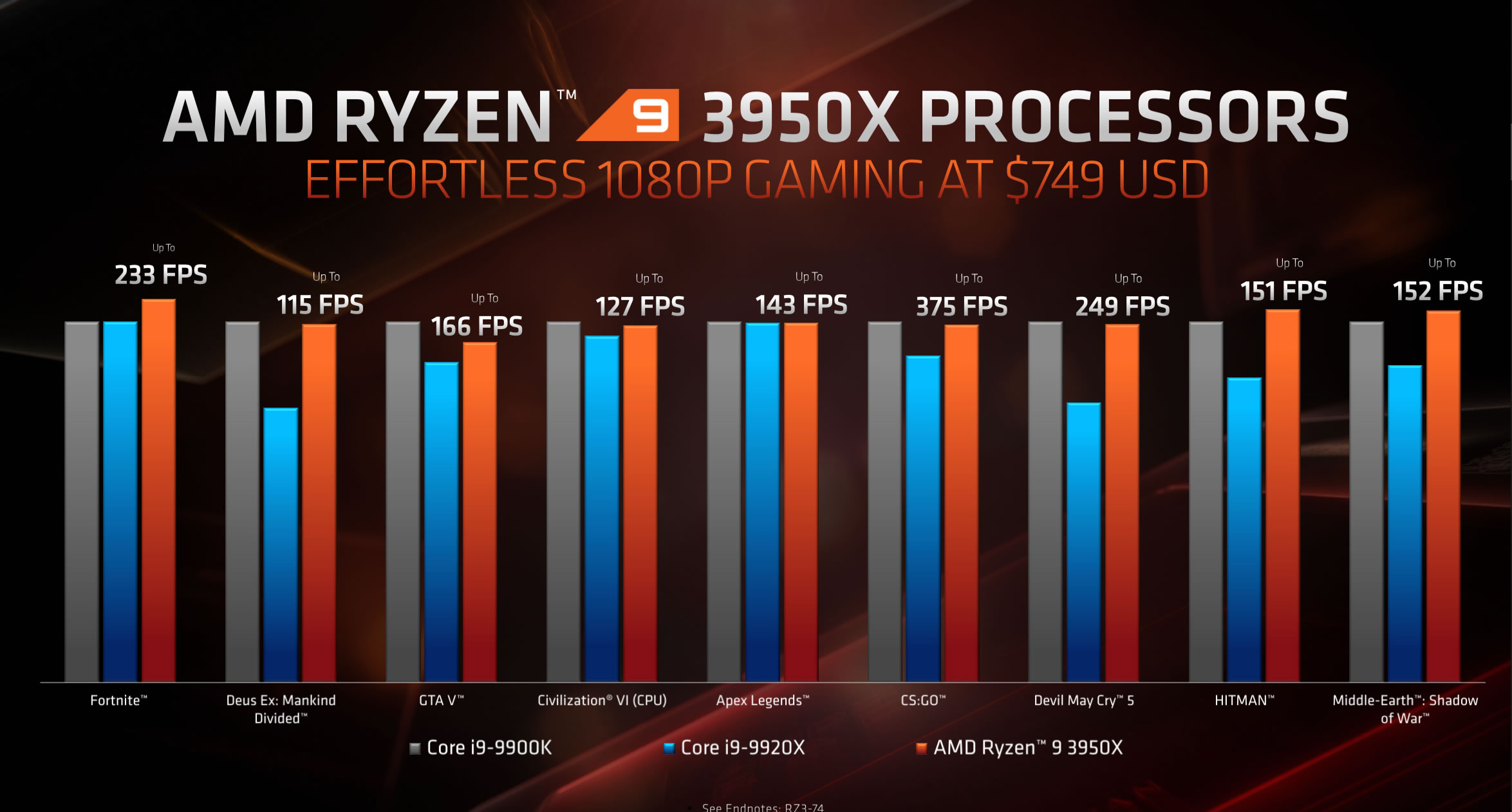
AMD recommends a 280mm AIO or better for those buying the 3950X. Despite sharing the same TDP rating as the 3900X, it doesn’t come with the Wraith Prism RGB box cooler, so you will have to buy a good cooler on top of the $750 price of admission for the CPU itself.
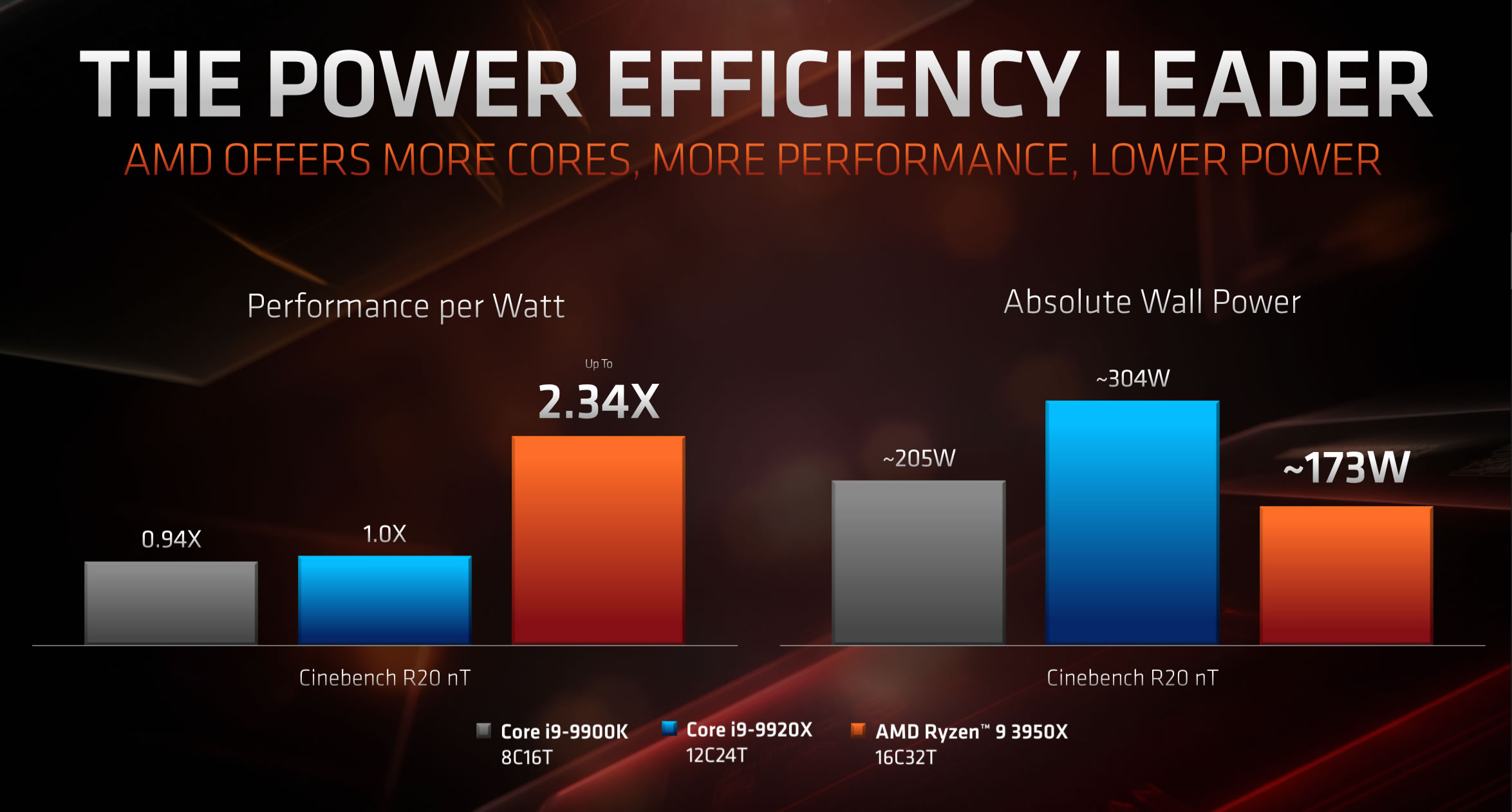
Upgrade prospects
Speaking of the $750 price, you might be thinking, it sounds like a nice CPU but the price is too high and I don’t need 16 cores right now. Both valid thoughts for a wide majority of builders today, but the 3950X is actually amazing news for future upgrades even for budget builders, adding a lot of value to the AM4 platform.
Had you invested in an inexpensive Intel Z390 motherboard with a $180 Core i5-8400, for example, your upgrade prospects don’t look great down the road. Most likely in a few years you’ll have the option of an overpriced 8-core CPU or face the reality of having to ditch your motherboard and start over. Meanwhile, those who bought a decent B350 or X370 motherboard, up to two years ago, will have in the not too distant future the option of buying a 12 or 16-core Ryzen CPU second hand. The Ryzen 7 2700X was released about a year ago for $330 and today you can snap them up second hand for as little as $150 on eBay. In another year there’s no way you’ll be paying over $100. Backing that claim, the 2 year old Ryzen 7 1700X which originally sold for $400, can now easily be had for $100, sometimes less. So we'd dare to say in 2 or 3 years you will be looking at paying half price for a 3950X.
It really is interesting to see how much life the AM4 platform has in it. If you’d told me back in 2017 this is where Ryzen would land us in less than 3 years, I’d have said you’re dreaming. To be fair though, 8 cores on a mainstream platform for ~$330 was pretty incredible at the time, so who knows, I might have just said anything’s possible at that point.
Bottom line, we have a release date for the Ryzen 9 3950X. Pricing of 3rd-gen Threadripper is probably higher than most were expecting, but if history serves any lesson those MSRPs could be discounted in the months to come to less than $1,000 for the entry level model. Despite heavy price cuts from Intel, AMD’s done the opposite and jacked their price points up some. Could we look at a changing of guard here? Intel CPUs were overpriced before, so we have a new reality where AMD won't claim victory that easily and Intel is more willing to compete head to head.
Shopping Shortcuts:
- AMD Ryzen 9 3900X on Amazon
- AMD Ryzen 7 3700X on Amazon
- AMD Ryzen 5 3600 on Amazon
- AMD Threadripper 2950X on Amazon
- Intel Core i9-9900KS on Amazon
- Intel Core i9-9900K on Amazon
- Intel Core i7-9700K on Amazon
- Intel Core i7-8700K on Amazon
- GeForce RTX 2080 Ti on Amazon
- GeForce RTX 2070 Super on Amazon
- GeForce RTX 2060 Super on Amazon
https://www.techspot.com/news/82663-amd-3rd-gen-threadripper-now-official-starting.html